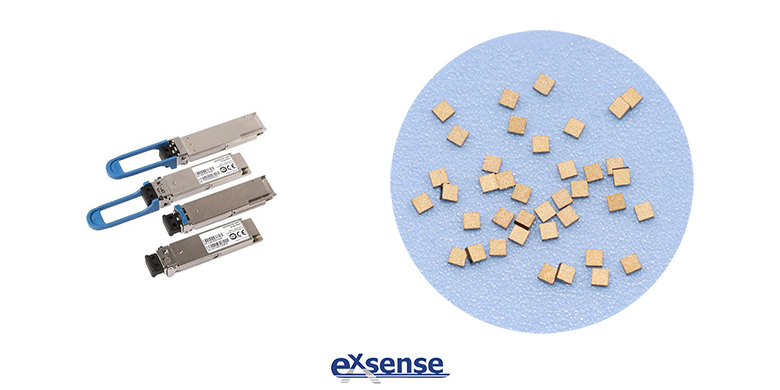
High-accuracy NTC thermistor chip (can up to ±0.5%, ±1%, ±2%, ±3%) produced by EXSENSE Electronics Technology Co., Ltd., with characteristics of high reliability, high sensitivity, rapid response, etc., which is widely used in optical module, infrared thermopile, semiconductor modules, etc..
Optical module is the core device of optical communication, which realizes the interface module of information transmission between devices through photoelectric conversion. It is composed of the receiving part and the transmitting part. Among them, the transmitting end converts the electrical signal into optical signal, and after transmission through optical fiber, the receiving end converts the optical signal into electrical signal, and the transmission medium is optical fiber. In short, optical communication is the communication that uses light wave as carrier to transmit information. As early as two thousand years ago, light transmission has been used, beacon tower is an ancient optical communication equipment. Our ancestors would build high beacon towers in the capital and border areas. When the enemy invaded, they would light fireworks on these beacon towers to convey the message of being invaded. When the vassals saw the fireworks, they would immediately lead troops to rescue them. Among them, also gave birth to the famous story of “Testing the vassals with beacon towers”.
Optical communication is widely used in our daily life. The Internet, mobile phones, IP phones and other internet-using devices that use the Network connect everyone to their region, to the entire country, and even to the global communications network. For example, the signals from computers and mobile phones are clustered in the base stations and network providers of local communications operators, then transmitted around the world through optical fibers in undersea fibre-optic cables. All kinds of devices we use in our daily life can be connected to the Internet. Optical communication makes our life more comfortable and convenient. The reason why optical communication can be widely used is due to the following advantages:
First, the transmission distance is long, economy and energy saving.
Suppose that 10GB of information (10 billion signals) are transmitted in one second, and that the signal is adjusted every 100 meters if electric communication is used. By contrast, with optical communications, the interval needed to adjust can be more than 100 kilometers. The fewer times the signal is adjusted, the fewer machines are used, so it is economical and energy efficient.
For example, when talking on the phone or chatting online with friends in foreign countries, the voice will not lag as it did in the past. In the era of only electric communication, the distance transmitted at one time is short and the amount of information transmitted is small. International communication is mainly transmitted through artificial satellites as relay, while optical communication is used to transmit long distance and more information at one time. Thus, through the use of optical fiber and cable laid on the seabed, it is possible to achieve natural communication with overseas.
Second, transmit massive information at one time
A large number of users can receive the required information (information, movies, news, etc.) at the same time, the electronic communication can only transmit up to 10GB (10 billion 0 and 1 signals) of information in one second, by contrast, optical communications can transmit up to 1TB (1 trillion 0 and 1 signal) of information.
Third, the speed of communication is fast
Electrical communication can be caused by electrical noise errors, resulting in a decrease in the speed of communication. However, optical communication is not affected by noise, so signals can be transmitted quickly.
The high-accuracy NTC thermistor chip researched and developed by EXSENSE Electronics, because of its high stability and high temperature resistance (operating temperature is -50 to 200℃), plays the role of temperature monitoring and temperature control in optical modules to ensure the normal operation of the module.



